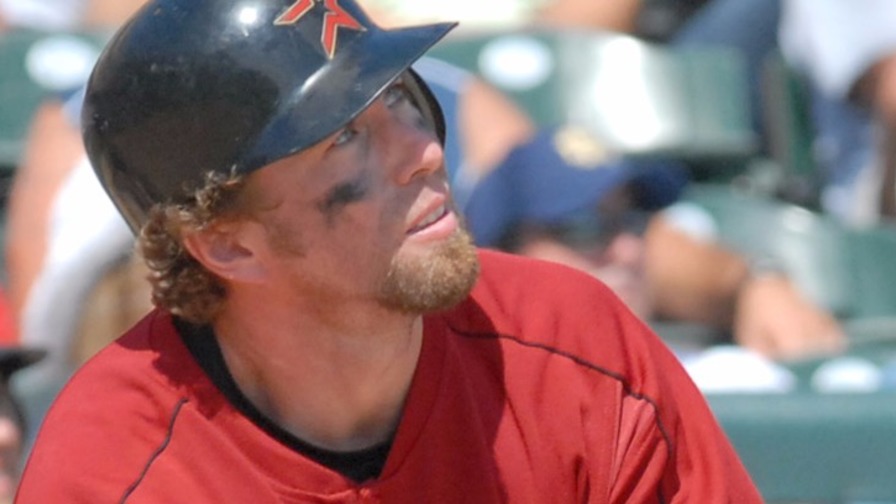Jeff Bagwell Lands a Well-Deserved Spot in the Hall of Fame

In his seventh year on the ballot, Jeff Bagwell, one of the most consistent first basemen in MLB history, was voted into the National Baseball Hall of Fame after garnering 86.2 percent of the vote.
The only surprise may be that it took as long as it did for the former Houston Astro to earn the necessary 75 percent of votes to gain entry, but that is likely the result of lingering steroid suspicions that have shrouded all power hitters of the 1990s and early 2000s.
During his 15-year career, he slashed .297/.408/.540, a feat only accomplished by 11 other players. That list is basically a who’s who of the game’s best sluggers, including Stan Musial, Lou Gehrig, Jimmie Foxx, Frank Thomas, Hank Greenberg, Babe Ruth, Ted Williams, Barry Bonds, Rogers Hornsby, Mickey Mantle and Manny Ramirez.
Outside of Bonds and Ramirez, every one of those players are already in the Hall of Fame.
Hall of Fame Landscape
Comparing Bagwell to the best and worst first basemen enshrined in the Hall of Fame reveals how deserving he is to have a plaque hanging in Cooperstown.
Among the 22 first basemen already in the Hall, Bagwell’s numbers more accurately resemble Foxx and Gehrig than some of the more questionable old-school members like George “High Pockets†Kelly and Frank Chance from the early 1900s. The players utilized for the upper and lower echelons as seen below were chosen based on career WAR.
| Player | AVG | OBP | SLG | OPS |
|---|---|---|---|---|
| Average Top 4 HOF 1B | .328 | .417 | .544 | .961 |
| Jeff Bagwell | .297 | .408 | .540 | .948 |
| Average Bottom 4 HOF 1B | .300 | .364 | .461 | .825 |
Model of Consistency
Starting right from his rookie year in 1991, the stocky first baseman showed a historic propensity for producing his now-heralded triple slash. After skipping Triple-A entirely, Bagwell ranked fifth with a .387 on-base percentage in his first big league campaign. That number has only been topped by eight rookies in the last 40 years.
By Baseball-Reference’s model for WAR, his rookie season (4.6 WAR) was one of the 30 best rookie performances in baseball history, while also checking in as the fifth-best for a first baseman.
Only 18 players have ever posted a .300/.400/.500 line over their first six seasons while playing in at least 100 games each year. The group is headed by Teddy Ballgame and Mike Trout, while being rounded out by players like Mel Ott, Bagwell's former teammate in Lance Berkman, and Joey Votto. Bagwell's 35.3 bWAR through his first six years in the big leagues ranks eighth among this group.
He held his own against Bonds in his prime (to the extent that is humanly possible), posting the fifth-highest wRC+ and the sixth-best OBP during this same timeframe. His plate discipline improved throughout his career, as he drew 834 walks between his age-28 and age-34 seasons, which is second to -- you guessed it -- Bonds.
During his prime from 1996-01, Bagwell solidified his prowess at the plate by posting six consecutive 30-homer, 100-RBI, 100-run performances.
Not Just About the Homers
One of Bagwell's most underrated talents was his ability to steal bags…well. He's part of the 400-homer/200-steal club -- which only has 14 members -- and he's the currently the lone first baseman to do it. In fact, no other first baseman has even racked up 200 homers and 200 steals throughout their career.
Those wheels didn’t take away from his power or ability to get on base, either. Of this exclusive club's 14 members, he holds the second-best career OBP and OPS, along with the fifth-highest slugging percentage.
Bagwell is also the only true first baseman in the 30-30 club, and he did it twice in 1997 and 1999. The closest competition he has here is Joe Carter, who accomplished it in 1987 while playing 84 games at first base and 64 in the outfield. However, that was the only season where he mostly played first base, a position he started at in just 15 percent of his career games.
It Didn't Matter Where He Played
Due to the timeline of his career, Bagwell's first nine seasons came in the spacious Astrodome before moving to Minute Maid Park (which was originally known as Enron Field). In those nine seasons, it was the toughest MLB park with regard to allowing home runs.
Surprisingly, or maybe it was simply foreshadowing his immense talent, those years didn’t greatly impact his home/road splits.
From 1991 through the Astros' final game there in 1999, Bagwell hit 129 homers at home and 134 on the road. So, it's safe to say that his performance on the road -- from a power perspective -- didn't carry the first decade of his career.
To further put into perspective how good he was despite playing home games at a park that wasn't hitter-friendly, he became the ninth player ever to post an OPS over 1.200 when he hit 39 homers and led the league with 116 RBI and 104 runs back in 1994.
Conclusion
Any way you slice it, Bagwell's numbers show that he enjoyed a Hall of Fame career.
As a former Rookie of the Year and unanimous MVP winner in the strike-shortened 1994 season – which came with a pinch of luck as he broke his hand one game before the strike began – Bagwell hauled in the most prestigious of honors Wednesday and will forever be remembered as one of the best first basemen in baseball history.
















